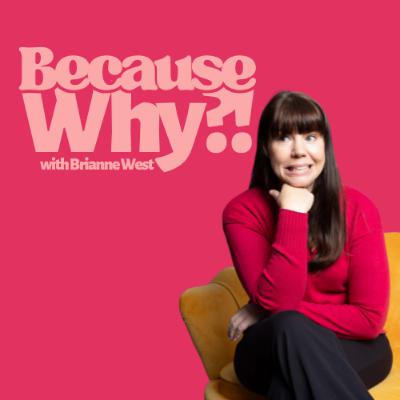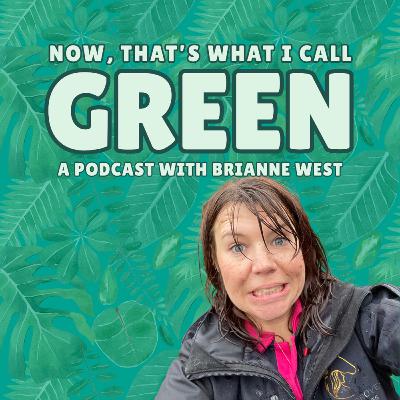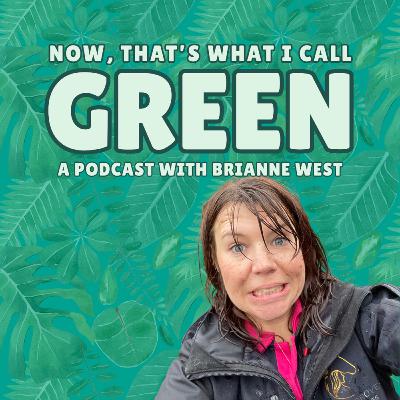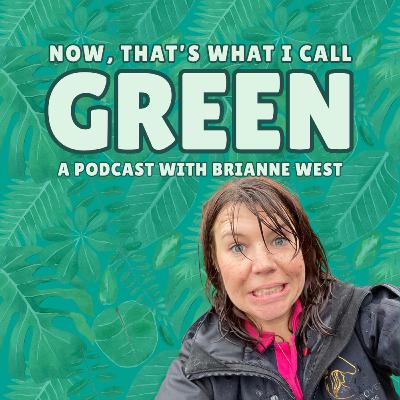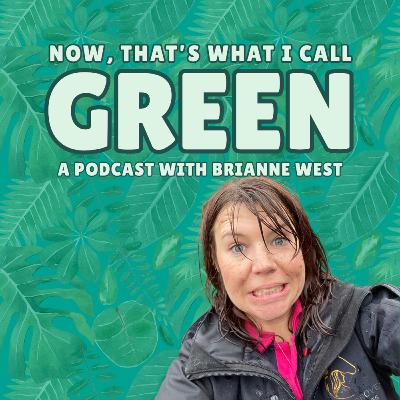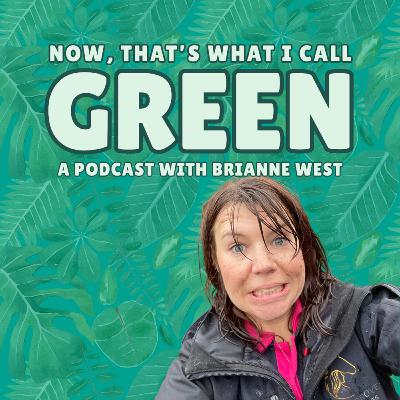Discover Because Why?! The Science and Society Pod.
Because Why?! The Science and Society Pod.

Because Why?! The Science and Society Pod.
Author: Brianne West
Subscribed: 20Played: 495Subscribe
Share
© Brianne West
Description
Curious about, well… everything? Same.
Welcome to Because Why?! Where science and nature, meets culture and business.
If you care about people and planet, and want to know how the world really works - and how we can do better, you're in the right place.
Because Why?! Because really, everything comes back to science.
Expect episodes on everything from climate change and sustainability, to ethical business and history, politics, nature, conspiracy theories, human behaviour and who knows what else. It's all interesting.
And unlike podcast bros, I have receipts.
Welcome to Because Why?! Where science and nature, meets culture and business.
If you care about people and planet, and want to know how the world really works - and how we can do better, you're in the right place.
Because Why?! Because really, everything comes back to science.
Expect episodes on everything from climate change and sustainability, to ethical business and history, politics, nature, conspiracy theories, human behaviour and who knows what else. It's all interesting.
And unlike podcast bros, I have receipts.
88 Episodes
Reverse
So, bottled water is kind of a scam. People think it’s healthier and safer, despite zero evidence to back that up. So… is it all just one giant marketing con? Well… kinda. In this episode, I’m taking you through the wild history of bottled water to show exactly how we ended up here - and why it’s so, so, so ridiculous! Quick note: I originally did the research and writing for this podcast in July 2024, so the stats I mention are current to that period.In this episode I go through:The surprisingly long history of bottled water (it’s been around way longer than you think)What needed to happen to make bottled water a massive global hitThe weird correlation between bottled water sales and countries that already have safe tap waterA statistical breakdown of where people are actually buying bottled waterThe shocking differences in testing requirements between bottled and tap waterHow bottled water companies harm the countries they source fromWhy microplastics could be way worse for our bodies than we realiseWhy bottled water isn’t automatically safer than tap waterThe facts about fluoride and chlorine in tap waterWhy nitrates in water are a concernThe jaw-dropping amount of water it takes just to make one bottle of waterThanks for joining me on this episode of Because Why?!Mā te wā - see you next week.You can get involved with the podcast online in the meantime, of course.Find our full podcast via the website here: https://www.nowthatwhatsicall.comInstagram: https://www.instagram.com/becausewhypod/You can follow me on socials on the below accounts.Instagram: https://www.instagram.com/briannemwest/Tiktok: https://www.tiktok.com/@briannemwestLinkedin: https://www.linkedin.com/in/briannemwest/For our latest big project, find out more about Incrediballs here: https://incrediballs.com/
Welcome to another This or That episode!I break down the least impactful options from things you’ve been asking about.This episode is actually a repost, because some of you have sent in these questions - clearly, we all have choices that keep us up at night. And often, what we expect isn’t actually the truth!In this week’s selection we have tea vs. coffee, and which is worse for the environment, what the best and worst options are for the milk you use with your drink, and finally, what exactly are bioplastics? And, whether we should even be using them...Let's talk about: The comparison of tea vs. coffeeHow much water it takes to make tea and coffee, respectivelyWhat the most sustainable version of milk isThe worst milk option for the environmentThe various environmental issues caused by dairy farmingThe truth behind a big myth about soy farming in the AmazonThe difference between bio-based plastics and biodegradable plasticsThanks for joining me on this episode of Because Why?!Mā te wā - see you next week.You can get involved with the podcast online in the meantime, of course.Find our full podcast via the website here: https://www.nowthatwhatsicall.comInstagram: https://www.instagram.com/becausewhypod/You can follow me on socials on the below accounts.Instagram: https://www.instagram.com/briannemwest/Tiktok: https://www.tiktok.com/@briannemwestLinkedin: https://www.linkedin.com/in/briannemwest/For our latest big project, find out more about Incrediballs here: https://incrediballs.com/
Welcome to a This or That episode! I break down the least impactful options from things you’ve been asking about.This episode is actually a repost, because some of you have sent in these questions - clearly, we all have choices that keep us up at night. And often, what we expect isn’t actually the truth!This week’s selection has a pretty controversial topic, and one that maaay just surprise you.See if you can guess the answers before I reveal them - and then let me know if you got them all!In this episode let's cover:What uses more energy, turning off lights or energy efficient bulbs?What has less of an impact, paper or plastic bags?What resources and processes are made to make paper bags?What matters more, what you eat or where its from?What parts of your food intake you should reduce to help lessen your impact? (Don't worry, I'm not telling you to completely give up your favourites.)Thanks for joining me on this episode of Because Why?!Mā te wā - see you next week.You can get involved with the podcast online in the meantime, of course.Find our full podcast via the website here: https://www.nowthatwhatsicall.comInstagram: https://www.instagram.com/becausewhypod/You can follow me on socials on the below accounts.Instagram: https://www.instagram.com/briannemwest/Tiktok: https://www.tiktok.com/@briannemwestLinkedin: https://www.linkedin.com/in/briannemwest/For our latest big project, find out more about Incrediballs here: https://incrediballs.com/
Welcome to the first episode under the brand-new banner, Because Why?! The show where my curiosity gets the better of me, and I drag you along for the ride. (You're welcome?)We’re still talking about the environment, but now the scope is much wider: science, ethical business, politics (even when it makes my eye twitch), and the weird, wonderful, and occasionally infuriating claims floating around out there.In this episode, I’m kicking things off with wellness trends, dodgy health claims, and overhyped “miracle” fixes people keep getting sold. From seed oil scaremongering to the microplastic “hoover,” cold plunges, cortisol face, and the mysterious world of “structured water,” let's dissect the pseudoscience to establish what’s true, what’s nonsense, and why these ideas catch on in the first place.In this episode, you’ll hear about:Seed oils - are they really as bad as people say? (No)The actual science behind seed oilsWhat the microplastic hoover is - and whether it works (It probably doesn't)How therapeutic apheresis really stacks upPractical tips to reduce your microplastic exposureWhy cold plunges might carry more risks than you thinkCan you really tell your stress hormone levels just by looking in the mirror? (No)What cortisol actually does in your bodyWhy “hormone balancing” is mostly myth and marketingThe three biggest reasons anecdotal evidence tricks usCan water really be “structured” or “vortexed” to be better for you? (No)The truth about hydrogen water and the science behind itIf you want to keep doing cold plunges, I’m happy for you! Just... be careful. And if you’ve got $20,000 burning a hole in your pocket, maybe think twice before signing up for a microplastic blood cleanse. The boring truth is usually what works: sleep, balanced diet, exercise, social connections.Thanks for joining me on this first episode of Because Why?! Mā te wā - see you next week.You can get involved with the podcast online in the meantime, of course.Find our full podcast via the website here: https://www.nowthatwhatsicall.comInstagram: https://www.instagram.com/becausewhypod/You can follow me on socials on the below accounts.Instagram: https://www.instagram.com/briannemwest/Tiktok: https://www.tiktok.com/@briannemwest Linkedin: https://www.linkedin.com/in/briannemwest/For our latest big project, find out more about Incrediballs here: https://incrediballs.com/Sources: Seed oils: (word count prevents proper referencing.)- https://doi.org/10.1016/j.jand.2012.03.029- https://doi.org/10.1186/1743-7075-8-36- https://doi.org/10.1161/CIR.0000000000000510- https://doi.org/10.1002/14651858.CD011737.pub3- https://doi.org/10.1161/CIRCULATIONAHA.114.010236- https://doi.org/10.1016/S2213-8587(17)30307-8
I wanted to talk about politics and combating polarising opinions… but I didn’t want to get dark about it.So, to help, I’ve called in my friend and optimism security blanket, Dave Richards. He’s one of those people who has realistic but optimistic insight into the world. He’s lived all over the world, has a deep cultural understanding, and just makes me feel better about the state of things.So I thought I’d have him join me for a bit of a wide-ranging, mostly optimistic chat about the state of the world.In this episode we talk about: The importance of maintaining optimism amid global and local challengesWhy politics often seems theatrical, but politicians may genuinely care about making changeThe fact that environmental progress over decades shows improvement, even if it’s hard to see in the short termThe significance of media literacy, critical thinking, and recognising manufactured divides and misinformationThe potential of podcasts and open dialogue to foster understanding across political and ideological linesWhy we should meet people where they are, find common ground, and avoid polarisationThe myth of political and societal "us vs them" dividesThe importance of science-based policies and genuine conversations, even with those holding opposing viewsHow media, algorithms, and social platforms influence polarisation and radicalisationIf you want to check out Dave’s incredible photography head along to his Instagram. Giveaway! This week, I'm giving away copies of Talking Across the Divide, by Justin Lee. It’s a brilliant read on how to actually talk to people you disagree with - something we all probably need a bit more of. Join me over on Instagram to enter.Find our full podcast via the website here: https://www.nowthatswhaticall.com/Instagram: https://www.instagram.com/nowthatswhaticallgreen/You can follow me on socials on the below accounts.Instagram: https://www.instagram.com/briannemwest/TikTok: https://www.tiktok.com/@briannemwestLinkedIn: https://www.linkedin.com/in/briannemwest/For our latest big project, find out more about Incrediballs here: https://incrediballs.com/
Imagine a fungus slipping into your bloodstream, hijacking every single neuron and freezing you alive while it knits its own flesh with yours.If you were an ant or a spider, that could be you — but thankfully, Ophiocordyceps doesn’t (yet) affect humans.In this Microgreens episode, we’re peering into the terrifying and slightly creepy world of fungi.In our main episode, we covered why fungi are important. Today, we’re getting into their dark side...In this episode I share:What the bleeding tooth fungus is and what it doesThe real-life zombie fungus and why it won’t affect humans any time soonHow glow-in-the-dark mushrooms workWhat the dead man’s fingers fungus isThe potential health benefits of lion’s mane mushroomsWhat slime mould is and why it can moveEpisode quote:“In fact, we are closer related to fungi than they are to plants.”Episode sources: Hydnellum peckii overview and atromentin info: https://en.wikipedia.org/wiki/Hydnellum_peckii Zombie-ant fungus life-cycle (National Geographic): https://www.nationalgeographic.com/animals/article/cordyceps-zombie-fungus-takes-over-ants 50-million-year fossil zombie fungus: https://www.sci.news/paleontology/allocordyceps-baltica-09786.htmlFungal bioluminescence pathway transferred to tobacco (open-access paper): https://www.ncbi.nlm.nih.gov/pmc/articles/PMC7681015/ Dead man’s fingers ecology note: https://purduelandscapereport.org/article/dead-mans-fingers/Lion’s mane (Hericium) neuro-protective review: https://www.ncbi.nlm.nih.gov/pmc/articles/PMC5987239/ Slime-mould maze-solving experiment (Nature 2000): https://www.nature.com/articles/35035159
Without this one thing, every single thing you know and love would disappear. Soil would fail, forests would starve, antibiotics would, well, vanish, and your morning coffee, bread, beer, and even chocolate would be gone. The thing I’m talking about is everywhere. It’s probably in your lunch. It’s almost certainly in your lungs. It’s in your sourdough starter, your compost heap. Got a clue yet? Most people don’t actually know what these things are. I’m talking about fungi. Fungi are not plants, not animals, not bacteria — they’re something else entirely. And they’re really, really old.They’re older than dinosaurs, older than sharks — they might even be older than plants, depending on how you define a plant.Today, I’m diving into something I’m actually violently allergic to: fungus. I’m covering everything from what fungi actually are (because it turns out most of us have no idea) to why they might be the most important thing on Earth… ish.In this episode I share: What prokaryotes and eukaryotes areWhat fungi actually areThe different types of fungiHow fungi moved from ocean to land and began a symbiotic relationship with plantsHow fungi can decompose almost anything — including radiationZombie fungus (and whether we should worry)How fungi reproduceWhy they’re incredibly usefulSome of the annoying and dangerous things they doHow we might use fungi to help fix the planet.Key quotes:"Fungi are more closely related to us than to plants.""Turns out plants talk way more than you think they do."Sources: Billion-year-old fungal fossils (Nature 2019): https://www.nature.com/articles/s41586-019-1217-0Armillaria “humongous fungus” 9 km² individual: https://www.scientificamerican.com/article/strange-but-true-largest-organism-is-fungus/Prototaxites 8 m Silurian-Devonian giant: https://www.science.org/content/article/ancient-giant-fossils-may-be-world-s-oldest-known-terrestrial-fungi90 % of plants with mycorrhizae (Nature Scitable): https://www.nature.com/scitable/knowledge/library/an-ecological-and-evolutionary-perspective-on-mycorrhizal-24286790/Mycorrhizal carbon sink 3–7 Gt CO₂ yr⁻¹ (Science 2022): https://www.science.org/doi/10.1126/science.abf3457Penicillin discovery background (Nobel Prize): https://www.nobelprize.org/prizes/medicine/1945/fleming/facts/Statins from Penicillium citrinum (review): https://www.ncbi.nlm.nih.gov/pmc/articles/PMC5958453/Cyclosporine discovery story: https://pubmed.ncbi.nlm.nih.gov/7568434/Psilocybin phase-II depression trial (JAMA Psychiatry 2021): https://jamanetwork.com/journals/jamapsychiatry/fullarticle/2787297Plastic-eating fungus Pestalotiopsis microspora (2011 study): https://pubmed.ncbi.nlm.nih.gov/22269855/ CDC overview of Candida auris drug resistance: https://www.cdc.gov/fungal/candida-auris/Chytrid fungus amphibian decline paper (Science 2006): https://www.science.org/doi/10.1126/science.1125069Mycoremediation and mycofiltration review (Biodegradation 2018): https://link.springer.com/article/10.1007/s10532-018-0914-8Find our full podcast via the website here: https://www.nowthatswhaticall.com/Instagram: https://www.instagram.com/nowthatswhaticallgreen/You can follow me on socials on the below accounts.Instagram: https://www.instagram.com/briannemwest/TikTok: https://www.tiktok.com/@briannemwestLinkedIn: https://www.linkedin.com/in/briannemwest/
Welcome to another "This or That" episode! This short, snappy installment investigates the sustainability of three topics you've asked me about, helping you make informed decisions. Today, it's: Electric Vehicles (EVs) vs. Hybrids, Cotton vs. Bamboo Fabric, and Bamboo vs. Plastic Toothbrushes.In this episode I share: EVs generally produce 50% fewer emissions over their lifetime compared to traditional internal combustion engine vehicles. How hybrids can offer a more accessible and affordable option. Why, despite the initial carbon footprint from battery manufacturing, EVs outperform hybrids. The types of people hybrids might be a better choice for. Why bamboo is often hailed as a more sustainable option. The main reasons cotton is resource-intensive. The pros and cons of organic cotton. Why bamboo's sustainability is nuanced and there are negative factors. Why the environmental benefits of bamboo toothbrushes depend on proper composting. The reason plastic toothbrushes with replaceable heads are emerging as a more sustainable option. Life cycle analyses show that plastic toothbrushes with replaceable heads consume less energy and water during production compared to bamboo toothbrushes.Key Quotes"Even if you live somewhere where the grid is primarily fossil fuel powered, EVs come out ahead.""When done responsibly, bamboo fabric can be a sustainable choice, but it is crucial to ensure that the processing methods have been considered.""Plastic toothbrushes with replaceable heads minimise waste, making them the most sustainable option currently available."More Information I mentioned I have a life cycle analysis of toothbrushes if you want more info, you can find it here.You can get involved with the podcast onlineFind our full podcast the website here: https://www.briannewest.com/podcastInstagram: https://www.instagram.com/nowthatswhaticallpodcasts/You can follow me on socials on the belowaccounts.Instagram: https://www.instagram.com/briannemwest/Tiktok: https://www.tiktok.com/@briannemwestLinkedin: https://www.linkedin.com/in/briannemwest/For our latest big project, find out moreabout Incrediballs here: https://incrediballs.com
Most of the cabs on the streets of New York back in 1899 were electric, so why did they disappear? And why has it been so hard to bring them back?In this episode, I am diving into the history of electric vehicles to reveal why a cleaner, quieter, and generally better technology got stamped out almost as quickly as it arrived.This is part of our series, “Inventions That Changed the World”, and I think you’ll find it very eye-opening.In this episode, I share:The early history of the electric carWhy electric vehicles vanished for almost a centuryThe 3 players that were quietly steering the EV off the roadHow EVs made an attempted return in 1990What stopped the EVs in the 1990sHow the emergence of Tesla influenced the latest EV surgeSome of the myths around EVs that influence people's hatred of themWhat’s being done to stop the atrocious slave labour in EV productionKey Quotes“EVs are better, end of story.”“In Aotearoa, 12% of our cars are electric.”“Most of the cabs on the streets of New York back in 1899 were electric.”Find our full podcast via the website here: https://www.nowthatswhaticall.com/Instagram: https://www.instagram.com/nowthatswhaticallgreen/You can follow me on socials on the below accounts.Instagram: https://www.instagram.com/briannemwest/TikTok: https://www.tiktok.com/@briannemwestLinkedIn: https://www.linkedin.com/in/briannemwest/For our latest big project, find out more about Incrediballs here: https://incrediballs.com/
Kia ora kaitiaki and welcome to the final episode in my nuclear energy mini-series. Over the last three episodes, I’ve taken you through the science, the messy history, and the chaos of radioactive disasters - but today? Today I’m answering the question I’ve been dancing around since the start:Do we actually need nuclear energy to hit our climate goals - or can we just stick with solar, wind, and good old hydropower?As always, the answer isn’t as straightforward as we’d like (and yes, I find that annoying too). But after wading through data, opinions, politics, and a few mild threats on LinkedIn, I’ve come to a conclusion that might help you cut through. In this episode, I talk through:Why nuclear is low-carbon… but still not a silver bulletWhat it really costs to build a reactor (spoiler: a lot)The massive difference between what’s possible in theory and what actually works in realityWhy New Zealand should probably never go nuclear (hello, earthquakes)How much land and water different energy sources really useAnd the biggest roadblock to progress: not physics, not finances… but peopleWe also take a little trip around the world - from France’s nuclear grid to Australia’s rooftop solar obsession, from China’s reactor production line to why tiny island nations are betting big on batteries.So - is nuclear the hero, the villain, or just a very expensive middle child?Tune in and find out. I promise I’ll actually give you an answer at the end. Kind of.Find our full podcast via the website here: https://www.nowthatswhaticall.com/Instagram: https://www.instagram.com/nowthatswhaticallgreen/You can follow me on socials on the below accounts.Instagram: https://www.instagram.com/briannemwest/TikTok: https://www.tiktok.com/@briannemwestLinkedIn: https://www.linkedin.com/in/briannemwest/For our latest big project, find out more about Incrediballs here: https://incrediballs.com/
It’s part 3 of our mini-series on nuclear power, and we’re talking about what’s going on in the reactor world and what the future of nuclear looks like.That might seem dull, but we’ll be discussing questions we need to know like: will we all have mini reactors to run our houses? Or nuclear batteries to power our phones? In this episode, I share:How different countries are currently using nuclear powerWhat nuclear waste actually is—and why it’s been over-villainisedThe issues around nuclear waste storage and how people are trying to solve themModular reactors and how they could help smaller places with little sunlightThe safer, better material that reactors could be using instead of uraniumWhat micro-reactors are and how they could help with disaster reliefWhether nuclear batteries could become an everyday thingWhat fusion is and why it's the ultimate in clean energyWhy we can’t use fusion yetKey Quotes“1 litre of sea water contains enough fusion fuel to equal 270 litres of petrol.”“Per person, a lifetimes use of electricity using nuclear would produce enough waste to fill a soda can.”“Fusion is the ultimate in clean energy.”“One nuclear plant supplies 25% of the UAE's electricity, which is bonkers.Find our full podcast via the website here:https://www.nowthatswhaticall.com/Instagram: https://www.instagram.com/nowthatswhaticallgreen/You can follow me on socials on the below accounts.Instagram: https://www.instagram.com/briannemwest/TikTok: https://www.tiktok.com/@briannemwestLinkedIn: https://www.linkedin.com/in/briannemwest/For our latest big project, find out more about Incrediballs here: https://incrediballs.com/
Part 2 of the Nuclear Mini-Series This is part two of my mini-series on nuclear power and whether it could be the clean energy solution we’ve all been waiting for.As I said before (and it bears repeating): fossil fuels kill about 8 million people every single year — more than the populations of Aotearoa and most of the Pacific Islands combined.Despite that, nuclear power remains the energy source we fear the most. But should we?In the last episode, we explored the science of nuclear — what it is, how it works, and why it’s not nearly as scary as it sounds. In this episode, we dive into its history — a sometimes horrifying, sometimes absurd, and often misunderstood timeline that shaped our collective anxiety around nuclear energy.In this episode, I cover:The early discoveries of nuclear materials and radiationHow public fear around nuclear energy really beganThe rise of nuclear bombs and the race for atomic powerWhat actually happens inside a nuclear reactor (in plain English)The major nuclear disasters that shaped global perceptionWhat went wrong at Three Mile IslandWhat made Chernobyl so catastrophicWhy Fukushima shook public confidence in nuclear safetyKey quotes:“Nuclear energy got its hideous reputation before it had even powered a single light bulb.”“Creepy green glows and mutant fish? That’s science fiction, not reality.”“Public anxiety about nuclear energy didn’t actually start with power stations.”Books & Resources Mentioned:Here are the books and materials I mentioned for anyone who wants to explore:The Radium Girls by Kate MooreA gripping and enraging true story of the young women who painted glow-in-the-dark watch faces with radioactive paint — and paid the ultimate price. The Woman Who Knew Too Much by Gayle GreeneA biography of Dr. Alice Stewart, who studied radiation risks and stood up to the nuclear establishment. (Recommended for broader radiation safety context).Atoms and Ashes: A Global History of Nuclear Disasters by Serhii PlokhyCovers Six major nuclear incidents — including Chernobyl, Fukushima, and Three Mile Island — with historical and political analysis.If you want to go down the rabbit hole, I also recommend googling:“Radithor” (yes, that glowing bottled water was real)“Clarence Dally and Thomas Edison” (the first radiation death in the U.S).Find our full podcast via the website here:https://www.nowthatswhaticall.com/Instagram: https://www.instagram.com/nowthatswhaticallgreen/You can follow me on socials on the below accounts.Instagram: https://www.instagram.com/briannemwest/TikTok: https://www.tiktok.com/@briannemwestLinkedIn: https://www.linkedin.com/in/briannemwest/For our latest big project, find out more about Incrediballs here: https://incrediballs.com/
Fossil fuels kill about 8 million people every single year, which is more than the populations of Aotearoa and most of the remaining Pacific Islands put together.Nuclear power, though - it’s the one that evokes all of that terror and fear, and, well, fair enough because radiation sickness is terrifying. But I am fascinated by nuclear energy ever since I found out that Chernobyl happened on my birthday, albeit the year before I was born, but still - fascinating.The big fact is that nuclear is a far safer way to create energy than fossil fuels.So it begs the question: if nuclear energy’s fatality rate is orders of magnitude lower than coal’s, why are we still burning coal like it's 1890?To get into this, I’m doing a 4-part series on nuclear power, and to start with, I’ll be discussing what it actually is.In this episode I share:What is an atom, what's it made of and how can they be changedHow atoms can become reactiveWhat nuclear reactions are and the creation of isotopesThe two types of radiationWhat the 4 main types of ionising radiation areNeutrons and their role in radiation and nuclear reactorsThe fear and danger that comes with radiationKey Quotes“Ionising radiation can knock electrons out of DNA molecules and that is what ultimately can lead to cancer.”“Ultimately radiation is if the neutron to proton ratio in an atom isn’t balanced, it calms itself by emitting energy.”Find our full podcast via the website here:https://www.nowthatswhaticall.com/Instagram: https://www.instagram.com/nowthatswhaticallgreen/You can follow me on socials on the below accounts.Instagram: https://www.instagram.com/briannemwest/TikTok: https://www.tiktok.com/@briannemwestLinkedIn: https://www.linkedin.com/in/briannemwest/For our latest big project, find out more about Incrediballs here: https://incrediballs.com/
Kia ora, I’m Brianne – and I’m the kind of irritating person who wants to talk about rewilding. Particularly wildflowers.If you follow me on social media, you might be over this topic. And if you are… I’m sorry, but you’re probably in the wrong place today — because that’s exactly what this episode is about.This one’s a little bit special. For one, Earth Day is basically right after this episode goes live, so it feels like a cosmic sign that we should talk about giving the planet some love.But also, rewilding isn’t something I’ve just read about in glossy magazines. It’s something I’ve been doing — actively — for years. And I’m absolutely seeing the payoff in my own garden. It’s really quite remarkable how quickly the planet can regenerate if we just leave it alone… or better yet, give it a helping hand.So I wanted to actually explain what rewilding is, how you can do it, and why it’s a bloody important thing to be doing.In this episode I share:What exactly rewilding isSuccessful rewildingAn example of rewilding working in a cityHow you can rewild an entire ecosystem by changing/fixing one elementWhat the sweet spot for the rewilding approach isIs de-extinction rewildingWhat has happened on my lifestyle block that I am rewildingWhat marine re wilding is and how it helpsOne thing any of you can do today to do a little bit of rewilding.Key Quotes“You don’t have to rewild in any particular way.”“We need healthy forests and wetlands and grasslands because they store carbon far more effectively than bloody pine forests do.”‘The idea that it’s just letting everything go wild is an over simplification.”Find our full podcast via the website here:https://www.nowthatswhaticall.com/Instagram: https://www.instagram.com/nowthatswhaticallgreen/You can follow me on socials on the below accounts.Instagram: https://www.instagram.com/briannemwest/TikTok: https://www.tiktok.com/@briannemwestLinkedIn: https://www.linkedin.com/in/briannemwest/For our latest big project, find out more about Incrediballs here: https://incrediballs.com/
It’s Easter time and we are all rushing to the stores to buy over packaged Easter eggs. While we love the taste of chocolate it’s a sad fact that every sale further supports forced labour and environmental destruction.I have spoken about this before and received a cease and desist letter from a chocolate company, even though everything I said was factually correct. This podcast focuses on sustainability and for this episode we are looking at an aspect of sustainability we don’t always discuss. People. We’ll be discussing why a lot of chocolate companies suck and who you should buy from instead.In this episode I share:The surprising place that 70% of the worlds cocoa beans come fromHow much profit the growers and farmers of cocoa take home compared to the companies that on sell itThe average yearly income of fair trade farmers and how it has increasedHow 80% of deforestation has occurred because of cocoa in some regionsHow fair trade is involved in fixing the social issues from chocolate purchasesThe flaws in the fair trade processWhat Direct trade is and it can also helpThe pros and cons of direct tradeThe social and environmental implications of palm oilHow a customer response to Cadbury has caused the company to make changes in the pastWhy switching from using palm oil is not the option to fix thingsWhat you can do as a consumer this easterTricks to look out for when it comes to certificationWhy you should skip easter eggs entirelyThe unbelievable amount easter eggs have increased by in priceMy recommendations for ethical chocolate for easter this yearWho I don’t recommend you buy from this easterKey Quotes“Chocolate, it's creamy it's sweet it melts in your mouth. But for every delicious bite you take, chocolate drives a bitter twisted tale of forced labour and environmental destruction.”“It's impossible to buy and do the right things all of the time.”“Sustainability is about progress not perfection. And it’s not about feeling guilty, because you can't be perfect, we are in a cost of living crisis.”More InformationChocolate I recommend:Tony's ChocolonelyMind Your TemperBennettoSolomons Gold ChocolateTrade AidHonest ChocolatShe Universe Find our full podcast via the website here:https://www.nowthatswhaticall.com/Instagram: https://www.instagram.com/nowthatswhaticallgreen/You can follow me on socials on the below accounts.Instagram: https://www.instagram.com/briannemwest/TikTok: https://www.tiktok.com/@briannemwestLinkedIn: https://www.linkedin.com/in/briannemwest/For our latest big project, find out more about Incrediballs here: https://incrediballs.com/
This one’s probably a bit of a bleaker episode, but it’s about something absolutely fascinating that we should know more about: Antimicrobial resistance. By 2050, it could kill more people than cancer.Now, in this episode I use the terms antimicrobial and antibiotic interchangeably. Technically they’re not the same thing — but for the sake of this episode, they are.This is a huge issue we’re all facing, and most of us are completely unaware of it.In this episode, I share:The history of antibiotic overuseWhat antimicrobial resistance actually isThe 3 types of microbial resistance — and why they should scare usThe pathogens that are really scary (because they resist antibiotics)Who will suffer the most from rising antimicrobial resistanceHow the anti-vax movement is making it harder to slow the spreadHow gene-editing technology is creating precision antibioticsThe best solution we have to this crisisHow geopolitics influenced Western scepticism about phagesWhy it’s hard to use phages in Western medicineAnd the few (but fixable) problems with phagesKey Quotes“More than 1.3 million people every year already die because antibiotics no longer work for them.”More info I mentioned the book the good virus which you can check out here.Find our full podcast via the website here:https://www.nowthatswhaticall.com/Instagram: https://www.instagram.com/nowthatswhaticallgreen/You can follow me on socials on the below accounts.Instagram: https://www.instagram.com/briannemwest/TikTok: https://www.tiktok.com/@briannemwestLinkedIn: https://www.linkedin.com/in/briannemwest/For our latest big project, find out more about Incrediballs here: https://incrediballs.com/
Biodiversity is a big deal - and no, it’s not just about having a few more birds in your garden. It’s about creating ecosystems that are healthier, more resilient, and able to withstand environmental stress. The good news is you don’t need acres of land to make a difference. Even a small backyard can become a thriving habitat if you know what to do.In this episode, I’m sharing practical tips on how to transform your outdoor space into a haven for wildlife, why insects are far more important than you think, and how small changes can lead to big improvements in biodiversity.In this episode, I share:What biodiversity actually is (hint: it’s about species variety, not just animal count)Why monocultures harm ecosystems and why polycultures are much betterHow trophic interactions regulate ecosystems and keep populations in checkThe terrifying truth about insect population collapse -and why that mattersHow biodiversity supports agriculture, medicine, and even tourismWhy pollinators, decomposers, and pest regulators are the unsung heroes of our ecosystemsActionable steps to make your garden a biodiversity havenKey Quotes"Biodiversity isn’t just a buzzword. It’s the foundation of healthy ecosystems.""Insects may not be glamorous, but without them, life on Earth would grind to a halt.""Monocultures are like food deserts for insects. A diverse garden feeds life at every level.""Even small changes - like planting native flowers - can make a massive difference to biodiversity."Find our full podcast via the website here:https://www.nowthatswhaticall.com/Instagram: https://www.instagram.com/nowthatswhaticallgreen/You can follow me on socials on the below accounts.Instagram: https://www.instagram.com/briannemwest/TikTok: https://www.tiktok.com/@briannemwestLinkedIn: https://www.linkedin.com/in/briannemwest/For our latest big project, find out more about Incrediballs here: https://incrediballs.com/
Today, I want to talk about one of the greatest environmental myths ever: recycling. When I say myth, I should probably say scam. We’ve been told that if we just recycle, we can solve the plastic crisis. But is that really true, or just a greenwashed lie designed to shift blame away from those responsible? Spoiler: it’s the latter.If you’ve been listening to this podcast for a while, you’ll know how much I despise the way recycling has been used to deceive the public - but you might not know all the details.So in this episode, we’re getting into the history and facts behind recycling.In this episode, I share:The long and complicated history of recyclingHow greenwashing and corporate blame-shifting have influenced recyclingThe introduction of the misleading arrow recycling symbolHow governments and corporations have used recycling as a smokescreenWhat actually happens to your recyclingWhy downcycling is the biggest problem with plastic recyclingWhy incineration and waste-to-energy schemes are a bad ideaReal solutions to tackle the recycling issueWhy manufacturers should be responsible for product disposal and recyclingThe truth behind biodegradable and compostable plasticsKey Quotes“Corporations are gearing up to produce 30% more plastic by 2030.”“In the USA less than 5% of plastic waste is recycled.”“At the end of the day the recycling system is fundamentally broken.”Find our full podcast via the website here:https://www.nowthatswhaticall.com/Instagram: https://www.instagram.com/nowthatswhaticallgreen/You can follow me on socials on the below accounts.Instagram: https://www.instagram.com/briannemwest/TikTok: https://www.tiktok.com/@briannemwestLinkedIn: https://www.linkedin.com/in/briannemwest/For our latest big project, find out more about Incrediballs here: https://incrediballs.com/
A few weeks ago, it was International Women’s Day which of course meant the usual corporate fanfare where they say how much they support women while simultaneously asking women to MC their events for free. It should go without saying that we are a long way off of closing the gender gaps in pay and investment and reaching gender equity…sadly it doesn’t and a lot of people need reminding. Last year for this episode I spent a lot of time highlighting all the issues, so I thought this year instead I’d actually highlight the amazing women who have had world changing influences both in the past and now. And then I’ll talk about what’s wrong today and how we could fix it. In this episode I share:The women who have been at the forefront of groundbreaking discoveriesThe forgotten female scientists who shaped the worldHow the scientific world continues to exclude and overlook womenThe female business leaders who built successful companies but rarely get creditThe subtle (and not-so-subtle) ways VC funding favours men over womenThe most common (and flawed) excuses people use to justify gender inequityWhat needs to change - and how we make it happen Key Quotes“A woman is either passive or aggressive, there is no just holding her own.”“Maybe we should be asking if men are too emotional to run things.”“So, I think it’s fair to say the sun will have expanded and absorbed earth before the investment pay gap is resolved.”“Women are just as good, if not better at business, than men.”Find our full podcast via the website here:https://www.nowthatswhaticall.com/Instagram: https://www.instagram.com/nowthatswhaticallgreen/You can follow me on socials on the below accounts.Instagram: https://www.instagram.com/briannemwest/TikTok: https://www.tiktok.com/@briannemwestLinkedIn: https://www.linkedin.com/in/briannemwest/For our latest big project, find out more about Incrediballs here: https://incrediballs.com/
Today we’re talking about something ingrained into modern civilisation that has huge impacts on climate change and human rights, but is something you may never really think about. Synthetic fertiliser.Yep, it’s responsible for feeding billions of people but it is also driving climate change, it's poisoning waterways, and it plays a major role in global conflicts. It’s impacts are huge, so I’m going to be giving you a quick run down on everything you need to know, and this will probably also include a little bit of a history lesson. In this episode I share:A quick history of nitrogen fertiliserWhy we needed new sources of nitrogenThe human labour and ecological image of the guano tradeThe scientist Fritz Haber and his impact on nitrogenThe unintended consequence of the haber-bosch methodHow Nazi Germany is connected to companies that make nitrogenThe biggest consequences of synthetic fertiliserHow these fertilisers make significant contributions to climate changeSolutions on how to deal with the nitrogen fertiliser problem Natural processes that could fix things Scientific breakthroughs in fertiliser Key Quotes“In a lot of agricultural regions nitrate levels in drinking water exceed safe levels.”“About half of the nitrogen in your body came from a fertiliser factory.”“Today we use about 230 million tonnes of synthetic fertiliser annually.”Find our full podcast via the website here:https://www.nowthatswhaticall.com/Instagram: https://www.instagram.com/nowthatswhaticallgreen/You can follow me on socials on the below accounts.Instagram: https://www.instagram.com/briannemwest/TikTok: https://www.tiktok.com/@briannemwestLinkedIn: https://www.linkedin.com/in/briannemwest/For our latest big project, find out more about Incrediballs here: https://incrediballs.com/


